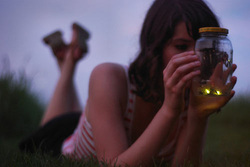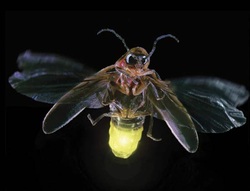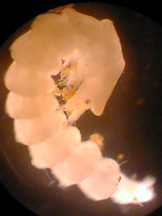|
Circa 1999 Flickering a Morse Code message of "love" to potential mates, fireflies light up the summer skies with their eerie greenish glow. Most people call them lightening bugs or fireflies, both common names are incorrect since these glowing bugs are really beetles, belonging to the Lampyridae family. Nearly all adults of both sexes are luminous throughout their lifetime even though the light's purpose is for courtship. Each beetle has its own light organ located at the tip of its abdomen. These lamps look like miniature flashlight bulbs; they have a flattened side that faces the world consisting of a transparent window while the inside back of the lamp is lined with a reflecting material much like the tapetum of the nocturnal eye. Every one of these light-producing organs contains over seven thousand cells, packed with minuscule granules of chemicals that include a complex organic compound called luciferin ( named for Lucifer, the Devil, originally known as the brightest of the angels.) These light organs also contain an enzyme called luciferase, and when these two chemicals meet in the presence of oxygen, magnesium ions, and adenosine triphosphate, they form oxyluciferin. The result is the cool green glow of cold light, light literally that produces no heat. At one time scientists would buy collected lightning bugs, snipping off their tails in order to obtain enough luciferin and luciferase for laboratory work. Today, the chemicals are produced through genetic engineering. Yet, after years of study, and knowing why this cold light is produced, nobody knows exactly how. Each species has its own code of flashes and uses them to attract mates in the darkness of the night. Within a few weeks after mating, the females lay their eggs in the ground, then the adults die. While the eggs develop, the growing larvae light up inside the eggs. After spending the summer eating, the glowworms dig small tunnels and spend winter in deep sleep. With the warming of spring, they emerge to eat again, then pupate, and finally reemerge as a new firefly population, ready to start the cycle again.
0 Comments
Leave a Reply. |
AuthorsCurrent and former staff members have contributed to our newsletter over the years. Now the articles are available to view here on our blog Categories
All
|
© 2024 Ski Landscape Corporation - Website by Day Design




 RSS Feed
RSS Feed